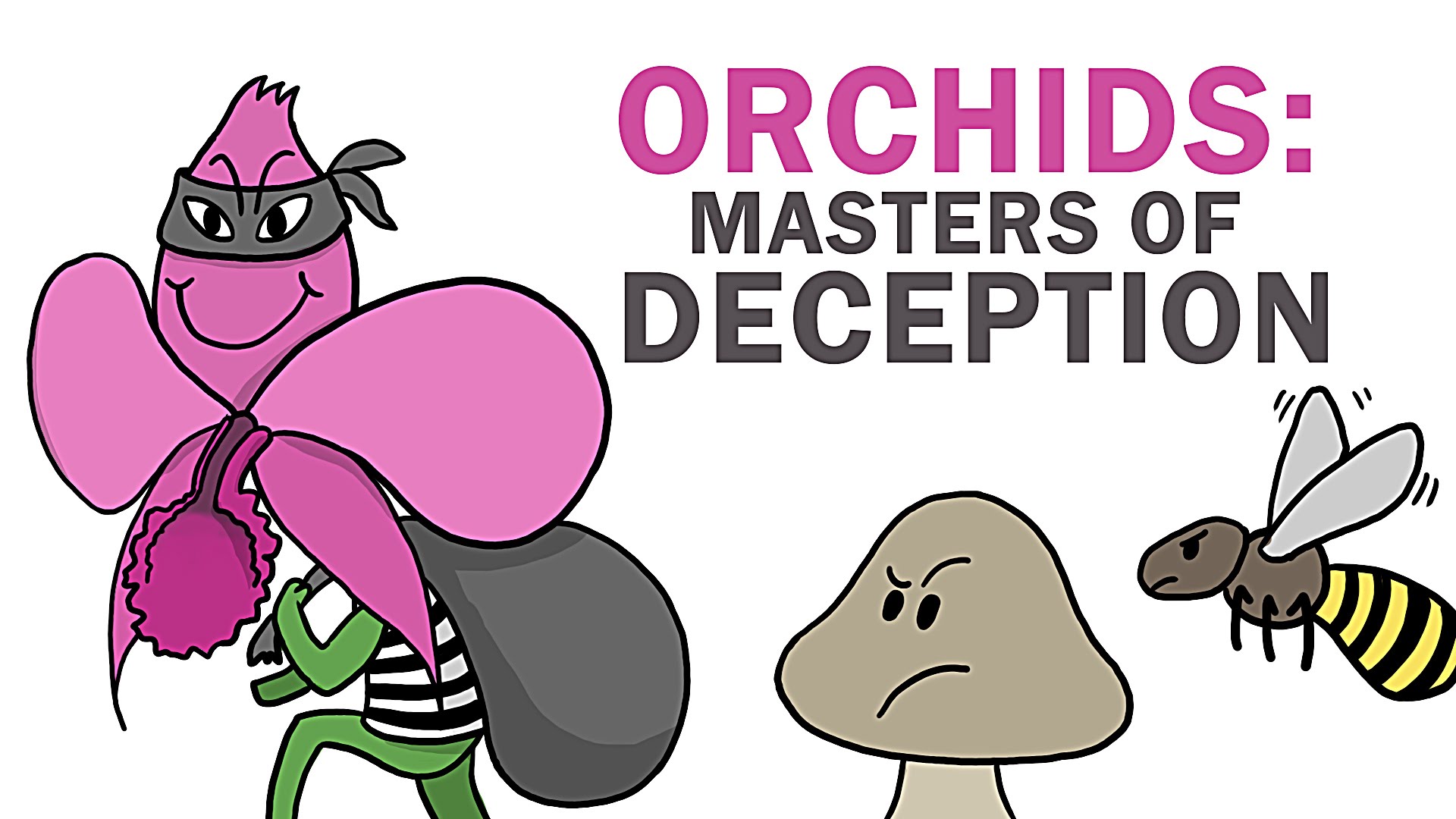Thanks to Curtin University and the University of Western Australia for sponsoring this video. Also, special thanks to Kingsley Dixon and the Orchid Specialist Group of the IUCN’s Species Survival Commission.
______
If you want to learn more about this topic, here are some handy keywords to get your googling started:
– Mycelium
– Mycorrizhae: a fungus that grows in association with the roots of a plant in a symbiotic or mildly pathogenic relationship.
– Mycoheterotroph: A plant that is completely reliant on fungus for all of its nutrition.
– Sexual deception: A trick used by numerous orchid species of looking and/or smelling like female insects in order to draw male insects to their flowers (for pollination)
– Food deception: Rather than offering pollinators real food rewards (such as nectar or pollen), some orchids merely mimic the looks and smells of other, nearby flowers that offer such rewards.
– Pollinia: In most flowering plants, pollen is a powdery substance made up of tons of individual pollen grains. But orchids pack their grains into a couple of sticky sacks (pollinia) instead.
– Epiphyte: A plant that grows harmlessly upon another plant. Lots of tropical orchids are epiphytes
– Lithophyte: A plant that grows on rocks
Species Featured in this video:
– Phantom Orchid (Cephalanthera austiniae)
– Bee orchid (Ophrys apifera)
– Fly orchid (Ophrys insectifera)
– Mirror orchid (Ophrys speculum)
– Red Helleborine Orchid (Cephalanthera rubra)
– Nettle-leaved bellflower (Campanula trachelium)
– Hammer orchid (Drakaea glyptodon)
– Wasp (Zaspilothynnus trilobatus)
– Lady’s slipper orchids (Cypripedium calceolus)
– Dracula orchids (Dracula terborchii and Dracula andreettae)
– Spider orchids (Genus Caladenia)
– Cigar Orchid (Cyrtopodium punctatum)
– Venus slipper (Paphiopedilum Maudiae)
______
Credits (and handles):
Script Writer: Peter Reich
Script Editor: Emily Elert (@eelert)
Video Illustrators: Omkar Bhagat (@TheCuriousEnggr) and Ever Salazar (@eversalazar)
Video Director: Emily Elert (@eelert)
Video Narrator: Emily Elert (@eelert)
With Contributions From: Henry Reich, Alex Reich, Kate Yoshida, Rachel Becker and David Goldenberg
Music by: Nathaniel Schroeder:
Image Credits:
Phantom Orchid – Miguel Vieira
Ophrys apifera – Hans Hillewaert
Ophrys insectifera – Bernd Haynold
Ophrys speculum – Wikimedia user Esculapio
Cephalanthera rubra and Campanula trachelium – Olivier Pichard
Hammer Orchid Animation based on Photos by Rod Peakall
Lady Slipper Orchid – Flickr user ladydragonflyherworld
______
References:
Cameron DD, Johnson I, Read DJ, Leake JR. 2008. Giving and receiving: measuring the carbon cost of mycorrhizas in the green orchid, Goodyera repens. New Phytologist 180: 176–184.
Cameron DD, Leake JR, Read DJ. 2006. Mutualistic mycorrhiza in orchids: evidence from plant-fungus carbon and nitrogen transfers in the green- leaved terrestrial orchid Goodyera repens. New Phytologist 171: 405–416.
Cameron DD, Preiss K, Gebauer G, Read DJ. 2009. The chlorophyll containing orchid Corallorhiza trifida derives little carbon through photosynthesis. New Phytologist 183: 358–364.
Givnish, T. J., Spalink, D., Ames, M., Lyon, S. P., Hunter, S. J., Zuluaga, A., . . . Cameron, K. M. (2015). Orchid phylogenomics and multiple drivers of their extraordinary diversification. Proceedings of the Royal Society B: Biological Sciences Proc. R. Soc. B, 282(1814), 20151553. doi:10.1098/rspb.2015.1553
Hopper, S. D., & Brown, A. P. (2007). A revision of Australia’ s hammer orchids (Drakaea: Orchidaceae), with some field data on species-specific sexually deceived wasp pollinators. Aust. Systematic Bot. Australian Systematic Botany, 20(3), 252. Retrieved April 28, 2016, from
IUCN Red List of Threatened Species. online April 27, 2016.
Koopowitz, H.. (1992). A STOCHASTIC MODEL FOR THE EXTINCTION OF TROPICAL ORCHIDS. Selbyana,13, 115–122. Retrieved from
Mccormick, M. K., Taylor, D. L., Juhaszova, K., Burnett, R. K., Whigham, D. F., & O’Neill, J. P. (2012). Limitations on orchid recruitment: Not a simple picture. Molecular Ecology, 21(6), 1511-1523. doi:10.1111/j.1365-294x.2012.05468.x
Merckx, V. and Freudenstein, J. V. (2010), Evolution of mycoheterotrophy in plants: a phylogenetic perspective. New Phytologist, 185: 605–609. Retrieved April 28, 2016, from
Rasmussen, Hanne N., and Finn N. Rasmussen. “Orchid mycorrhiza: implications of a mycophagous life style.” Oikos 118.3 (2009): 334-345.

